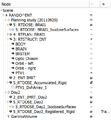2017 Winter Project Week/SubjectHierarchyRefactoring
From NAMIC Wiki
Home < 2017 Winter Project Week < SubjectHierarchyRefactoring
Key Investigators
- Csaba Pinter (Queen's)
- ? (JC, Steve, Andras)
- Jorge Onieva
Project Description
| Objective | Approach and Plan | Progress and Next Steps |
|---|---|---|
|
Although the subject hierarchy mechanism is in place and is already used, there are several issues and limitations that cannot be addressed in its current form:
These issues are due to
This necessitates a re-design of the subject hierarchy mechanism. The proposed solution is to store the whole subject hierarchy tree in one node, the internals of which are synchronized with the data nodes of the scene. A new Qt item model needs to be implemented for this node that supplies the information to the tree view and the future node selectors. |
|
|

